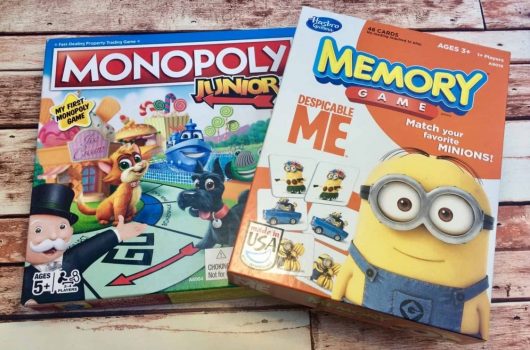Teaching your toddlers to play board games early in life has a lot of rewards. Board games are not only a fun way to spend time together, but they also can teach your toddler a wide variety of skills that they will use their entire life. We tested all kinds of board games for toddlers and have gathered our favorites in each category for you below.
- Features to Consider in Good Board Games for Toddlers
- Top 14 Best Board Games for Toddlers 2023
- 1. Best Overall Board Game For Toddlers: The Sneaky, Snacky Squirrel Game
- 2. Best Bingo Game for Toddlers: Zingo
- 3. Best Strategy Game for Toddlers: My First Castle Panic
- 4. Best Matching Game for Toddlers: Disney Matching Game
- 5. Best First Competitive Board Game for Toddlers: Candy Land
- 6. Best Active Board Game for Toddlers: The Family Treasure Hunt Game
- 7. Best Board Game for Early Readers: The Ladybug Game
- 8. Best Competitive Counting Game for Toddlers: Hi Ho! Cherry-O
- 9. Best Cooperative Game for Unsupervised Play: Count Your Chickens
- 10. Best Word Game for Toddlers: Boggle Junior
- 11. Best Classic Board Game for Toddlers: Chutes and Ladders
- 12. Best Shape Recognition Game for Toddlers: Frankie's Food Truck Fiasco
- 13. Best Hidden Object Game for Toddlers: VATOS Match Board Game
- 14. Best Stacking Game for Toddlers: Stack Up!
- The Verdict
Features to Consider in Good Board Games for Toddlers
Picking the Best Board Game for Your Toddler
Young children learn best through play. When a toddler plays a game, they are only concentrating on the fun they are having, not the lessons that the game is teaching them. Because they naturally teach skills like reading, math, and logic, board games are a particularly powerful tool for early development. This is why we suggest parents surround their toddlers with interesting games spanning a wide variety of skills and concepts.
What to Look for in a Toddler Board Game
There are a bunch of board games for parents of toddlers to choose from. To help you decide which one is right for your little ones, we looked at several aspects of each game. Here are the criteria we used to review the games:
- Skills Required: Rather than looking at the recommended ages on the box, we suggest parents choose board games for their toddlers based on their skills. Early childhood development can follow many paths, so you should pick games that suit your child’s individual skills.
- What They Will Learn: For most parents, the most important part of choosing a board game for their toddler is what skills they will learn by playing.
- Competitive or Cooperative: Board games where kids compete against each other are good for developing sportsmanship and fair play while cooperative games help develop communication and teamwork. Toddlers should be exposed to a mix of both kinds of games.
- Duration: Most toddler games are made to be played quickly. Parents should make sure they choose a game that matches their toddler’s attention span.
- Number of Players: Unlike board games for older kids, all the board games on this list can be played with only two people. Parents with larger groups of children will want to check out games with a higher player count.
- Is it Fun?: A board game can be very educational, but it’s not going to teach anything if it’s sitting in the closet. In order to make our list of best board games for toddlers, a game needs to be fun to play.
- Choking Hazards: Some games have pieces that could be dangerous for toddlers who are prone to putting things in their mouths. We’ve made sure to indicate which games are safe for unsupervised play for these little ones.
Top 14 Best Board Games for Toddlers 2023
1. Best Overall Board Game For Toddlers: The Sneaky, Snacky Squirrel Game
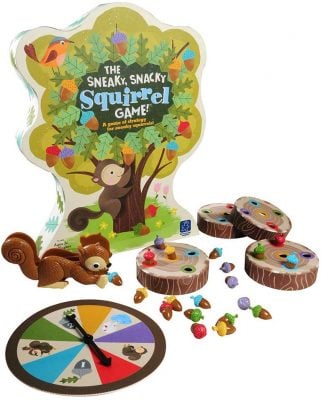
Editor’s Rating:
Recommended Ages: 3+
Number of Players: 2-4
Duration of Game: 20 minutes
Competitive or Cooperative? Competitive
Possible choking hazard? Yes
In the Sneaky, Snacky Squirrel Game, kids race to be the first to help their squirrel fill up their log with acorns. On their turns, players use the spinner to determine what color acorn to collect. After they know their color, they must grab a matching acorn with the Squirrel Squeezer and place it into their log. There are also spaces on the spinner that allow them to pick any color or steal an acorn from another player. There’s also a space that makes them lose an acorn.
Our favorite thing about the Sneaky, Snacky Squirrel Game is the included Squirrel Squeezer. The Squeezer works like a pair of tongs and is perfectly suited for little hands. It also looks adorable and makes picking up the acorns a little more difficult without being too frustrating. We also liked the brightly colored acorns but they are definitely a choking hazard for younger toddlers.
Skills Required: To play the Sneaky, Snacky Squirrel Game, kids only need to be able to match colors and be able to use the Squirrel Squeezer.
What they will learn: This game reinforces color matching, promotes motor skills and rewards basic strategy. The Sneaky, Snacky Squirrel Game also teaches good sportsmanship as it can be particularly frustrating when players get unlucky and have their acorns lost or stolen.
Pros
- Great board game for toddlers developing fine motor skills
- Colorful acorns and well-designed Squirrel Squeezer
- Box, spinner, and logs are made from high-quality cardboard
Cons
- Stealing acorns can lead to hurt feelings
2. Best Bingo Game for Toddlers: Zingo
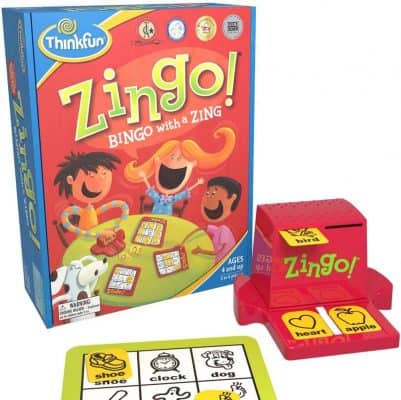
Editor’s Rating:
Recommended Ages: 3+
Number of Players: 2-6
Duration of Game: Under 5 minutes
Competitive or Cooperative? Competitive
Possible choking hazard? Yes
Described as “Bingo with a Zing”, Zingo challenges two or more players to race against each other to fill all nine squares on their board first. Rather than the numbers found in bingo, spaces on Zingo cards are filled with simple words and illustrations. There are more advanced versions of Zingo for older kids as well.
The reason this game is so much fun to play is the included “Zinger” device. This is the device that dispenses the tiles players use to cover spaces on their Zingo board. With a quick sliding motion, the Zinger spits out two tiles face-up on the tray below where they can be grabbed by the fastest player with a matching space on their board.
Skills Required: In order to play Zingo, players must be able to match the images and words on the tiles dispensed by the Zinger to the same images and words on the card in front of them.
What they will learn: Toddlers who play Zingo will improve their language skills, concentration, and recognition of words and images.
Pros
- Best game for toddlers learning sight words
- Innovative Zinger device is fun to use and keeps the game moving
- Promotes memory and quick recall
Cons
- Because speed is a factor, toddlers may get frustrated playing this game with older kids. Rules may need to be adjusted to keep the game fun in these situations.
3. Best Strategy Game for Toddlers: My First Castle Panic
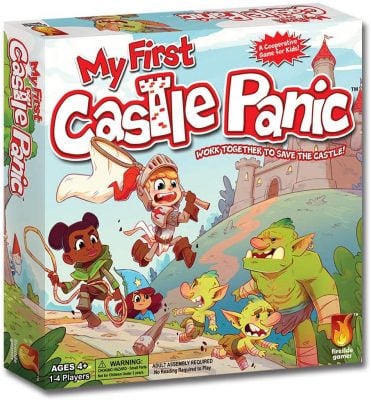
Editor’s Rating:
Recommended Ages: 3+
Number of Players: 1-4
Duration of Game: 20 minutes
Competitive or Cooperative? Cooperative
Possible choking hazard? No
In My First Castle Panic, the castle is under attack and all players need to work together to save it! This cooperative game is simple enough for toddlers but has enough strategy that older kids will be happy to join in the fun as well. The simple game board represents the path to the castle. As monsters approach, players must play cards with matching symbols in order to capture them. Some of the monsters have special abilities that make them harder to catch.
My First Castle Rush is a great cooperative game for kids with older siblings. The rules encourage lots of communication and the best strategy for winning is for players to share cards with each other at the right times. The players won’t always win the game, but everyone will have fun and the whole group will win or lose together.
Skills Required: With very few skills required, My First Castle Panic is a fantastic board game for any toddler who can learn a few simple rules and match shapes. This is the most advanced cooperative game we reviewed, but toddlers should have no problem playing all by themselves.
What they will learn: Toddlers playing My First Castle Panic will improve their teamwork, shape matching ability and communication. The game also develops strategic planning and teaches kids to win or lose as a team.
Pros
- My First Castle Panic is a fun cooperative strategy game for toddlers
- After a few rounds with parents or older players, little ones should have no problem playing unsupervised
- Teaches teamwork and sharing
Cons
- Some of the special monster abilities are a little confusing for very young players
4. Best Matching Game for Toddlers: Disney Matching Game
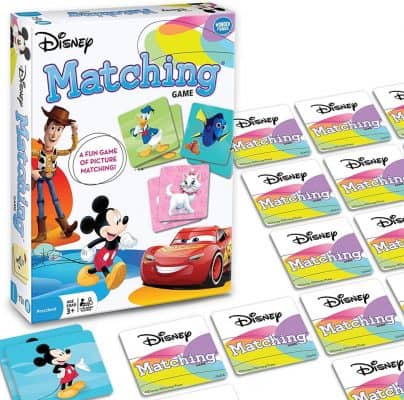
Editor’s Rating:
Recommended Ages: 3+
Number of Players: 1+
Duration of Game: 15 minutes
Competitive or Cooperative? Both
Possible choking hazard? Yes
Disney characters are a great subject for a memory matching game. This is because these are the same characters known and loved by children around the world already, it’s much easier for kids to focus on remembering where the tiles are. Parents of Frozen obsessed toddlers will be happy to know that Anna and Elsa are included as well.
We were impressed by the quality of the game tiles, which are made from sturdy, recycled cardboard. The illustrations on the tiles are bright and high-quality as you would expect from Disney. One small issue with the game is that the background colors of some tiles can be seen even when the card is face down allowing players to narrow down which characters it could be. This is very difficult to notice, however, and requires getting very close to the tile in order to see it.
Skills Required: There is no reading or math needed to play the Disney Matching Game. Players will improve as their memory develops.
What they will learn: While this game is mostly focused on improving memory, players also develop focus and critical thinking skills.
Pros
- Great game to help toddlers improve memory
- Large roster of Disney characters printed on colorful tiles
- High-quality tiles made from recycled cardboard
Cons
- Some background colors can be faintly seen around the edges when tiles are face down
5. Best First Competitive Board Game for Toddlers: Candy Land
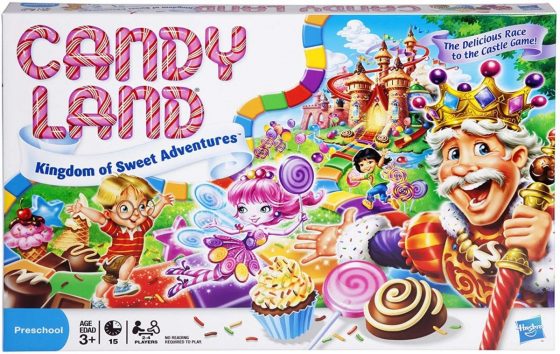
Editor’s Rating:
Recommended Ages: 3+
Number of Players: 2-4
Duration of Game: 15 minutes
Competitive or Cooperative? Competitive
Possible choking hazard? No
In Candy Land, up to four players race to be the first to reach King Kandy’s castle. Each player controls one of the four brightly colored gingerbread man pieces as it moves along the illustrated board. While traveling through Candy Land, players will pass landmarks like the Gumdrop Mountains and the Lollipop Woods while avoiding perils like getting stuck in licorice or the Molasses Swamp.
We like that instead of a spinner or dice, players draw cards from a pile to determine how far their piece will move. Rather than telling players how many spaces they can move, each card reveals either one or two blocks of color. The player then moves their token to the next one or two squares of that color. There is also a handful of cards with pictures of the residents of Candy Land mixed in that let players move to special spaces.
Skills Required: In order to play Candy Land, toddlers must be able to match colors from the cards they draw to the colors of the squares on the game board.
What they will learn: In addition to teaching color matching, Candy Land is a perfect introduction to board games for a toddler.
Pros
- Candyland is one of the best-selling toddler board games of all time
- Color-based movement means no counting or reading is required
- Parents who played earlier versions will enjoy the updated board art
Cons
- Cards can bend or rip after repeated use
6. Best Active Board Game for Toddlers: The Family Treasure Hunt Game
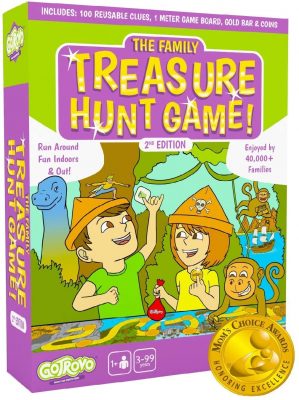
Editor’s Rating:
Recommended Ages: 3+
Number of Players: 1+
Duration of Game: 1 hour
Competitive or Cooperative? Cooperative
Possible choking hazard? Yes
When most parents think of board games, they think of a group of kids huddled around a table and not getting any exercise. The Family Treasure Hunt Game by Gotrovo is an exception to that rule. Featuring a treasure map puzzle board, each game requires an adult or older child to hide 10 gold coins and a gold treasure bar box.
Rather than just picking random hiding locations, the person hiding the treasure is assisted by 100 reusable clue cards. Not only do they provide great ideas for hiding spots, but they also add a really fun puzzle-solving element to the game.
Because there is no limit to the number of players, The Family Treasure Hunt Game is a great choice for parents hosting a party full of toddlers. While the magnetic gold bar treasure box is large enough to hold all kinds of goodies to reward a successful treasure hunt, a prize is not a necessity for having a great time.
Skills Required: While the help of an older kid or an adult will usually be needed to figure out some of the clues. Kids of any ability level can join in and contribute to the team by helping search for the treasure.
What they will learn: The Family Treasure Hunt Game teaches kids to cooperate, communicate and solve problems together.
Pros
- The Family Treasure Hunt Game will get kids of any age using their brain and moving their body
- Playable both indoors and outdoors
- 100 reusable clue cards make setting make up a scavenger hunt a breeze
Cons
- Set-up requires assistance from an adult or older kid
7. Best Board Game for Early Readers: The Ladybug Game
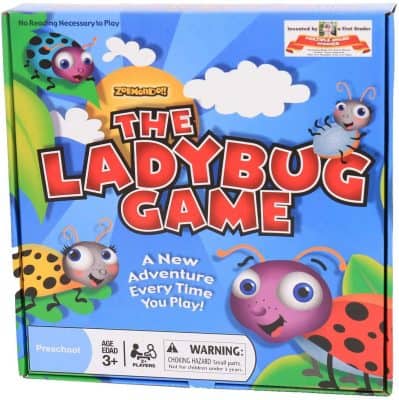
Editor’s Rating:
Recommended Ages: 3+
Number of Players: 2+
Duration of Game: 20 minutes
Competitive or Cooperative? Cooperative
Possible choking hazard? Yes
Kylie Copenhagen was only six years old when she invented The Ladybug Game as a 1st-grade assignment. The game has since sold over a million copies, won several awards and received praise from groups such as the Parent’s Choice Foundation. Our favorite part of the Ladybug Game is how it takes rules and game mechanics that are usually not found in toddler-friendly games and presents them in such a way that even any toddler with basic reading and counting ability can learn how to play very quickly.
The first thing we noticed about The Ladybug Game was the long, colorful board with large, easy-to-read text and a clearly defined path with large spaces. Each card included with the game includes simply worded directions using big, colorful letters and numbers. We heard from lots of parents who praised this clear presentation, saying that it greatly improved their little one’s confidence in reading and math in a short amount of time.
Skills Required: The Ladybug Game requires some reading and counting, however, it is a very friendly game for younger toddlers who are a struggling with either skill.
What they will learn: Toddlers will develop language skills, math skills, pattern recognition, and symbol matching while playing The Ladybug Game. They will also learn a lot about ladybugs!
Pros
- Invented by a 1st grader, The Ladybug Game does a great job of teaching toddlers how to play.
- Our favorite educational game for three-year-olds.
- The perfect game for toddlers who are right on the verge of being able to read simple words.
Cons
- The game comes with lots of little pieces that can be lost.
8. Best Competitive Counting Game for Toddlers: Hi Ho! Cherry-O
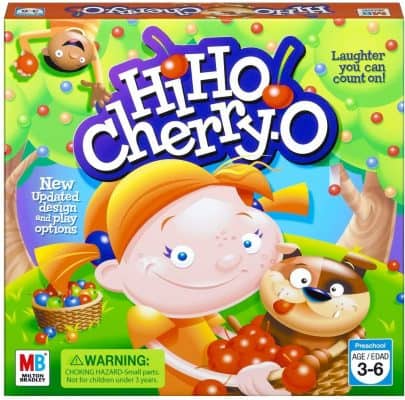
Editor’s Rating:
Recommended Ages: 3+
Number of Players: 2-4
Duration of Game: 20 minutes
Competitive or Cooperative? Competitive
Possible choking hazard? Yes
The goal of Hi Ho! Cherry-O is simple, pick all the cherries off of your tree before your opponents do the same to theirs. It’s a charming game that was originally published in the 60s. A 2015 update adds a lot to the classic game, introducing 4 different colored fruit pieces as well as new rules for a cooperative variation of the game.
Despite the improvements, the rules remain as easy-to-understand as ever. On each player’s turn, they flick the spinner and then place the indicated number of cherries into their basket. There are also spaces requiring players to take the cherries out of their basket and return them to the tree. The worst result on the spinner is the dreaded spilled bucket, forcing players to remove all the cherries from their buckets and begin all over again.
Skills Required: Hi Ho! Cherry-O only requires players are able to count to four.
What they will learn: Hi Ho! Cherry-O is a great game that will teach toddlers counting and sorting.
Pros
- Best competitive counting game for toddlers
- Plucking cherries off the tree and dropping them into the bucket is fun for all ages
- 2015 update adds new cooperative game
Cons
- Some parents with fond memories of the original game liked the old plastic game board better than the redesigned cardboard board. Thankfully for these parents, a re-issuing of the classic Hi Ho! Cherry-O game is also available.
9. Best Cooperative Game for Unsupervised Play: Count Your Chickens
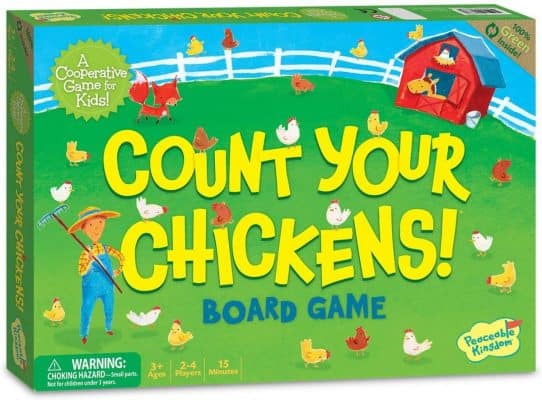
Editor’s Rating:
Recommended Ages: 3+
Number of Players: 2-4
Duration of Game: 15 minutes
Competitive or Cooperative? Cooperative
Possible choking hazard? Yes
In Count Your Chickens, players work together to round up a group of baby chicks who have flown the coop. In order to return to the babies to Mama Hen, players will have to cooperate and take turns counting after each spin. The simple rules make this game easy to play for any toddler who has started to learn how to count.
Count Your Chickens is a great game for parents who want a game to play with very young children. Parents we talked to liked how easy this game was for multiple toddlers to play together without adult help, but some noted that the simplicity of the game makes it a little too boring for older siblings to join in the fun.
Skills Required: This game requires no skills to play with a parent or older siblings. To play Count Your Chickens by themselves, toddlers need basic counting ability. Finding out if you win at the end requires being able to count to 40.
What they will learn: Count Your Chickens teaches counting up to 40. It also teaches teamwork and taking turns.
Pros
- Best cooperative counting game
- Fast 15-minute game keeps kids active and engaged
- Whimsical art on the game board as well as the pieces
Cons
- Too simple to be enjoyed by older kids as well as toddlers
10. Best Word Game for Toddlers: Boggle Junior
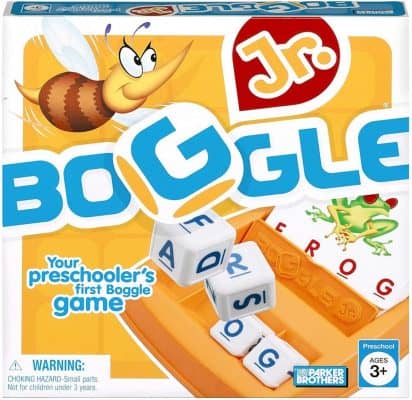
Editor’s Rating:
Recommended Ages: 3+
Number of Players: 1-2
Duration of Game: 10-15 minutes
Competitive or Cooperative? Competitive
Possible choking hazard? Yes
With two-difficulty levels, Boggle Junior is a fun word-building game that can help teach your child letters and how to spell. Boggle Junior comes with the same letter-filled dice as the famous adult version but instead of having to use the letters on the dice to build their own words, kids use the dice to match the words and images printed in the card.
The included cards offer 60 four-letter sight words for kids to spell. The cards sit in a holder with spaces for 4 dice. Players must arrange the dice in the holders so that the word on the card is spelled out. The word is spelled out on the card so younger players will only have to match the letters. As your kids get more advanced at spelling, the holder can be adjusted to conceal the written words, showing only the pictures.
Skills Required: To play the basic Boggle Junior game, players need to be able to match the letters on the dice to the letters written on the cards. For the advanced game, children must be able to spell common sight words.
What they will learn: Boggle Junior teaches and reinforces the reading and spelling of many common words.
Pros
- Best spelling game for toddlers
- Two difficulty levels help kids learn to identify letters and spell basic words
- 60 sight words included, each with colorful illustration
Cons
- Game is only designed to be played by 1-2 players at once
11. Best Classic Board Game for Toddlers: Chutes and Ladders
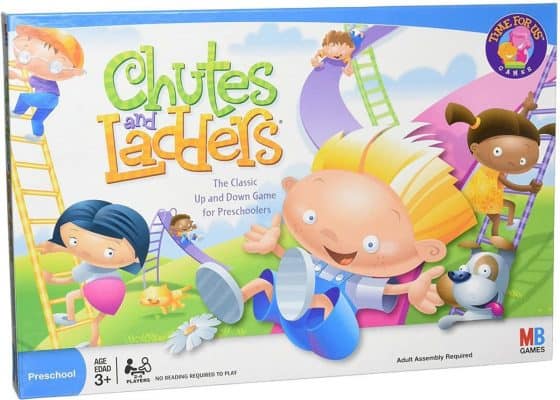
Editor’s Rating:
Recommended Ages: 3+
Number of Players: 2-4
Duration of Game: 20 minutes
Competitive or Cooperative? Competitive
Possible choking hazard? Yes
A classic game of chance, Chutes and Ladders has taught counting and sportsmanship since it was originally brought to the USA in the 1940s. The game is a localization of Moksha Patam, an ancient Indian game created in the 13th century.
The gameplay of Chutes and Ladders is simple and totally luck-based, meaning there is no strategy whatsoever. The board is comprised of 100 numbered spaces and each player takes turns flicking the spinner and then advancing their token the number of spaces indicated. When a player lands on a space with a ladder, their piece climbs the ladder to the higher number, advancing them closer to the finish line. Landing at the top of a chute, however, sends their piece plummeting down to the lower number, making it harder to reach the finish.
Skills Required: Basic counting ability is all that is required to play Chutes and Ladders.
What they will learn: While kids do not make any decisions that have an impact on the result of the game, Chutes and Ladders delivers a timeless lesson about the ups and downs of life.
Pros
- Simple gameplay for the whole family
- No reading required to play
- Teaches counting up to 100
Cons
- Some parents we talked to did not like the redesigned board art
12. Best Shape Recognition Game for Toddlers: Frankie's Food Truck Fiasco
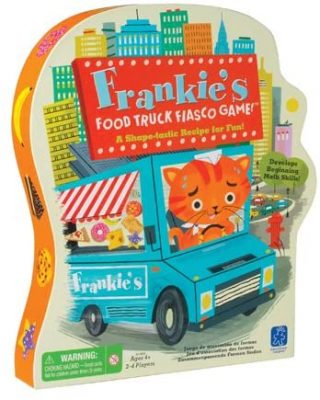
Editor’s Rating:
Recommended Ages: 4+
Number of Players: 2-4
Duration of Game: 10-15 minutes
Competitive or Cooperative? Competitive
Possible choking hazard? Yes
It’s lunchtime and Frankie the cat has a big line of customers waiting to be fed. Unfortunately, the food has gotten totally mixed up! It’s up to players to help find all 5 courses on today’s menu and save the day.
In Frankie’s Food Truck Fiasco, players take turns matching shapes in order to collect food that matches their menu. On their turn, players flick a spinner with several outcomes. If the spinner lands on a shape, the player must pick up a food item from the truck with a matching symbol. There are also spaces like “Yuck! A Fly in My Soup!” that forces players to return a food item from their mat and “That Looks Delicious!” which allows players to snag food from other players’ mats.
There is more strategy to Frankie’s Food Truck Fiasco than first meets the eye, once players realize that some of the shapes are rarer than others, the competition for those pieces becomes more intense. We also really liked the addition of the included tongs that adds an extra element to the game and helps build motor skills.
Skills Required: To play Frankie’s Food Truck Fiasco, players need to be able to match simple shapes.
What they will learn: Toddlers playing Frankie’s Food Truck Fiasco will learn to recognize geometric shapes like crescents and stars. The game also teaches strategic thinking.
Pros
- Teaches toddlers basic geometric shapes like stars and crescents
- Teaches basic strategy and probability
- Helps develop fine motor skills
Cons
- Frankie’s Food Truck Fiasco misses an opportunity to educate kids about healthy eating. We wish that they included more healthy foods as game pieces rather than candy and doughnuts
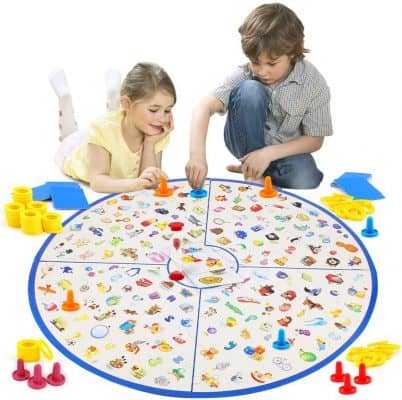
Editor’s Rating:
Recommended Ages: 3+
Number of Players: 2+
Duration of Game: 10-15 minutes
Competitive or Cooperative? Both
Possible choking hazard? Yes
Lots of board games we looked at had colorful illustrations to complement the game, but with the VATOS Match Board Game, the illustrations are the game itself. The VATOS Match Board is a large circular board divided into 4 sections. Printed on the board are 180 drawings of a wide variety of objects ranging from animals to household objects. This board can then be used for several games that challenge your toddler to find the answer on the board.
While the instructions provided are not in perfect English and can be somewhat confusing, there are lots of great games that can be played with the board, the included cards and game pieces. At the heart of all of the games is the fun of frantically searching the board for a picture that matches the clue, There are more ways to play with the VATOS Match Board than any other board game we tested.
Skills Required: This game is good for toddlers of any skill level. Basic reading is required for some of the more advanced games in the package.
What they will learn: The VATOS Match Board Game teaches toddlers observational skills, critical thinking, and concentration.
Pros
- Large colorful gameboard makes it fun to search for items
- Several different ways to play
- Helps improve your toddler’s attention span and observational skills
Cons
- The included English instruction manual is poorly written
14. Best Stacking Game for Toddlers: Stack Up!
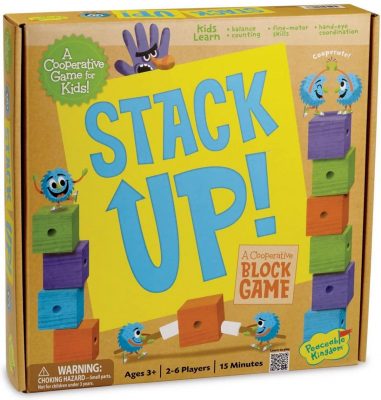
Editor’s Rating:
Recommended Ages: 3+
Number of Players: 2-6
Duration of Game: 15 minutes
Competitive or Cooperative? Cooperative
Possible choking hazard? Yes
Stack Up! is a cooperative block building game where players team up to build a block tower 12 blocks high before the Stack Smasher comes and knocks it down. Instead of stacking the blocks by hand, advanced players are challenged to use stack sticks that make placing the block more difficult. The stack sticks can be held in two different ways for different levels of difficulty.
Stack Up! Was the only cooperative game we reviewed in which every player gets to choose their own level of difficulty. This means that the game can be equally challenging for kids with big age gaps, which enhances the teamwork element. We also liked that knocking over the tower just once does not end the game. Instead, every time the blocks fall, the monster called the Stack Smasher moves one space closer to to the end of the game board. If the Smasher reaches the end, it’s game over and one of the players uses him to topple the tower.
Skills Required: To play using the easiest difficulty, toddlers only need to be able to build a block tower using their hands. As motor skills improve, they can begin playing using the stack sticks.
What they will learn: Stack Up! teaches toddlers to work together and is helpful for the development of fine motor skills for kids of any age.
Pros
- Adjustable difficulty lets each player choose the right difficulty level for themselves
- Added challenge cards add more variety to the game
- Great game for kids of all ages
Cons
- We wish the game came with more blocks so we could see how high we could keep building the tower
The Verdict
As you can see, there is a huge selection of great toddler-friendly board games for toddlers to choose from. We had a great time revisiting some old favorites and discovering the next generation of board games for young kids.
We firmly believe that every young child should have access to a wide variety of games designed to teach them different skills. Playing games with your toddlers is a great way to interact and connect with them in unique ways. Not only will you have fun together, but studies show that families that play games together are happier and communicate better.
